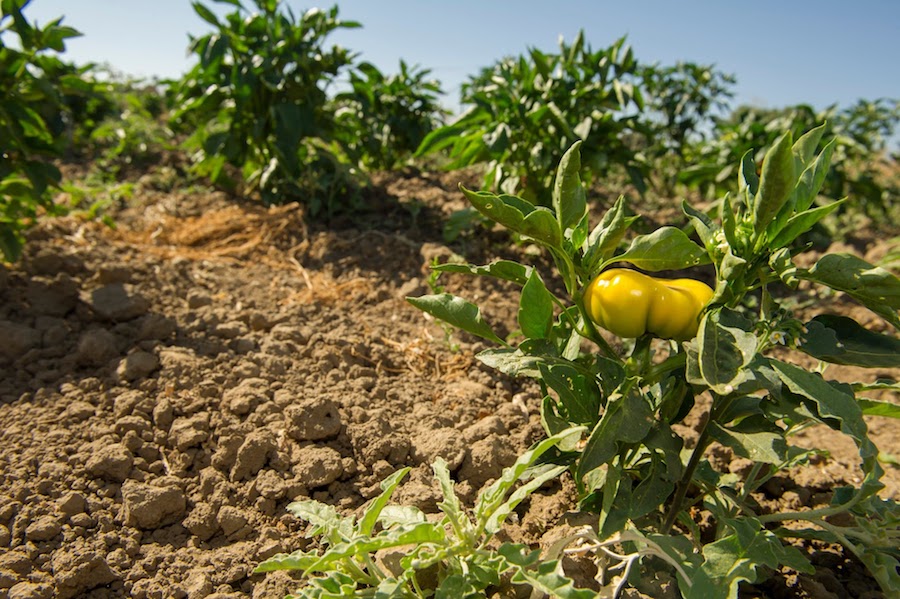
UC Davis students use plant breeding methods to improve characteristics of vegetables
Imagine a pepper that has the heat of a jalapeño, but the depth and size of a bell pepper. That combination would make a perfect pepper for poppers, chile relleno and other tasty fillings. While this type of cultivar, a variety produced by selective breeding, already exists, some UC Davis students are focused on creating a jalapeño/bell pepper variety that is more sustainable, as well as teaching students how to take on leadership roles.
Jorge Berny, a postdoctoral researcher in the plant sciences department, has been researching peppers since he was an undergraduate. Upon coming to Davis for his Ph.D. in 2012, Berny was introduced to the Student Farm, which is known for its effective sustainability practices. Originally, it was just Berny and a handful of students using space at the Student Farm for K-12 education and the peppers project.
“There were some [jalapeños] that they advertised were big jalapeños, and they were not [actually] big or productive,” Berny said. “We thought, maybe we could do better.”
Saarah Kuzay, now a second-year Ph.D. student, is one of the first people who worked with Berny. She is currently one of the “mentor” figures of the peppers project and likes how the model of recruiting and teaching students is also sustainable.
“A student would join the project, they would get taught by the senior, the mentee would become the mentor and recruit their own student,” Kuzay said. “It was this neat process of teaching a craft and passing it onto the next person. They liked that model enough that when Charlie Brummer, the current leader of the Plant Breeding Center, joined, he said we should really do this with more crops. So he wrote this grant proposal to the USDA, and we got a $1 million grant, as opposed to a $10,000 or less a year.”
Berny said that plant breeding is similar to a permit test. The rules could be learned in a book, but that couldn’t replace hands-on learning. Working with undergraduates also gave him room to not just teach, but grow from their observations.
“Sometimes, you just do stuff because that’s how you’ve been doing that for some time,” Berny said. “There’s always room for improvement.”
The team originally had little space for planting and was lucky to have up to 50 plants for the first few years. However, with the backing of the Plant Breeding Center and the grant, the project was able to support paying more students and provide space to put out more plant trials.
Charlie Brummer, along with then-Student Farm director Mark Van Horn, thought the project had a unique way of letting undergraduates experience hands-on learning with plant breeding and genetics as well as how to become leaders. They felt the precedent of the peppers project could be applied to other vegetables, which became the tomatoes project and the lima beans project.
“I thought there was a possibility that we could develop some breeding programs on the small scale that would give students actual in-field experience,” Brummer said. “Students could run the project, maybe get some idea on how things work that would then be useful for them later in the job market.”
The main focus of the peppers project is to make a jalapeño with a larger cavity to fit more ingredients like cheese, meat and other vegetables. Kuzay and others on the project produced a short video in 2016 on what plant breeding is, how their research was going and highlights of those who contributed to the peppers project. Kuzay believes the project should be completed within 2 to 3 years, barring any major disasters.
However, with each generation, other plant trials are also tested, allowing research to effectively “restart” a possible failure or even start new projects, like working with orange jalapeños or improving the resistance of bell peppers. Brumer said that, at minimum, it takes 7 to 8 years for a variety to be marketable, since it needs to be durable in the long-term and account for various environmental factors.
“As you get closer to getting something good, you want to trial that around,” Brummer said. “Make sure it isn’t, for some reason, just pretty well adapted to the student farm in Davis, but doesn’t do particularly well when you put it on different soil types or in different farms that have different managements.”
A concern that Kuzay, Brummer and Berny share is the public’s opinion on genetics. Plants genetics, and genetics in general, has been a difficult topic for scientists to talk about to the public. It often gets linked to biotechnology, which some of the public does not see in a positive light. Kuzay believes that for some people, the problem lies in the abstractness of a project and how detached the research seems from a person’s daily life.
“I’ve maintained for a long time that [this type of project] starts with an idea and ends with a product, just like how we do inventing,” Kuzay said. “We invent new cars, we invent new things, and we also invent new plants. That’s kind of what we’re doing. It’s a creative process that people can benefit from. They can taste it, eat it, see it.”
She thinks a good way to start re-introducing people to plant genetics is to make it appear non-threatening, accessible and personal.
“It’s not something abstract that’s high and lofty,” Kuzay said. “It’s something that anybody could do.”
Written by: Jack Carrillo Concordia — science@theaggie.org



